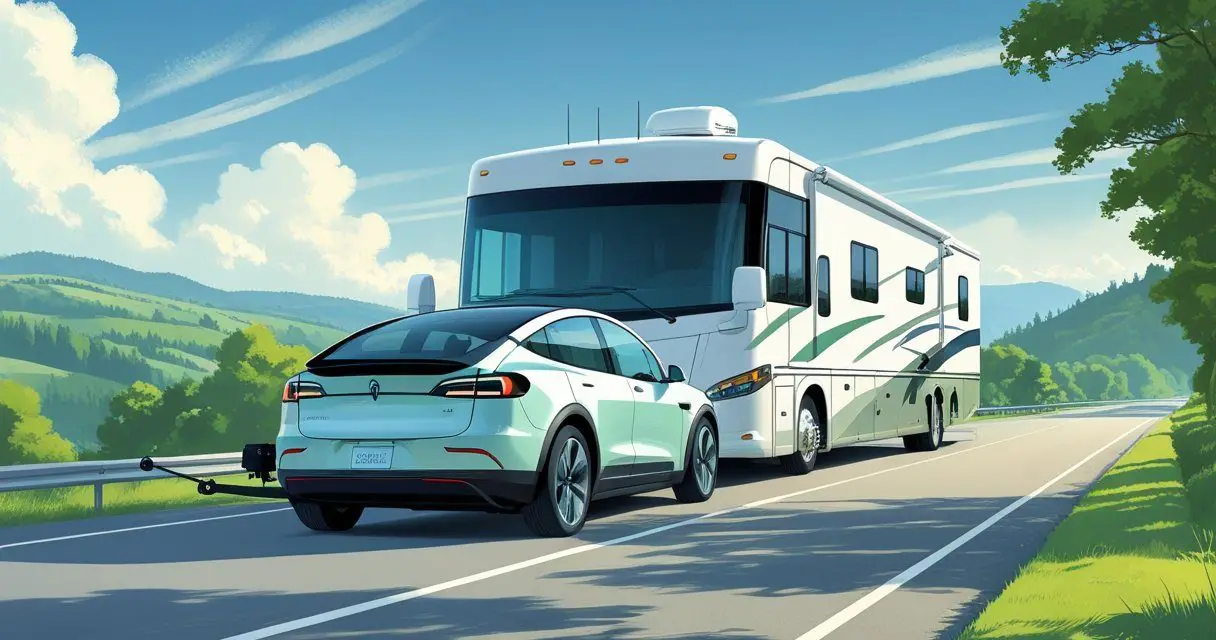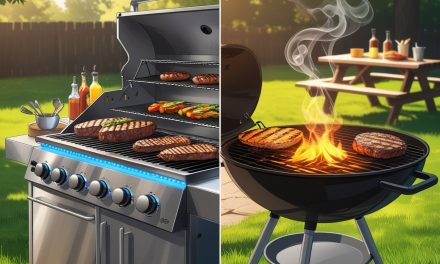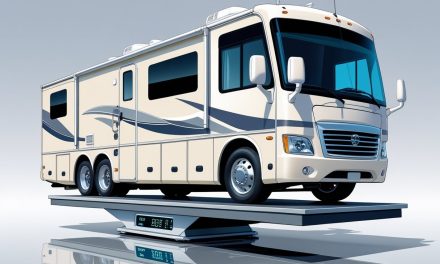Would you like to save this article?
Many RV owners wonder if they can bring their electric car along on their next adventure. The rise of electric vehicles has created new questions about towing methods and safety.
Most electric cars cannot be flat towed behind an RV due to their drivetrain design, which can cause serious damage to the electric motors when all four wheels are on the ground. Unlike traditional gas vehicles, electric cars have motors directly connected to the wheels that keep spinning even when the car is in neutral.
This creates problems that don’t exist with regular cars. You still have options for bringing your electric car on RV trips.
Understanding the different towing methods and their risks will help you make the right choice for your situation. New developments in electric vehicle technology may also change what’s possible in the future.
Key Takeaways
- Electric vehicles cannot be safely flat towed because their motors stay connected to the wheels even in neutral
- Trailer towing with all four wheels off the ground is the safest method for transporting electric cars behind RVs
- Future electric vehicle designs may include features that allow for safe flat towing with charging capabilities
Understanding Towing Methods for Electric Cars
Electric vehicles require different towing approaches than gas cars due to their unique drivetrains and electrical systems. Most electric cars cannot be flat towed safely, making dolly or trailer towing the preferred methods.
Flat Towing vs. Dolly and Trailer Towing
Flat towing means pulling a vehicle with all four wheels on the ground. This is the easiest method for RV owners since you don’t need extra equipment to store.
Most electric vehicles cannot be flat towed. The electric motor stays connected to the wheels even when the car is in neutral.
This causes the motor to spin while being towed, which can damage expensive parts. Dolly towing lifts the front wheels off the ground.
You place the front wheels on a two-wheeled trailer. This method works for some electric cars but not all.
Trailer towing puts the entire electric car on a flatbed trailer. This is the safest method for electric vehicles.
All four wheels are off the ground, so no parts get damaged. Here’s how each method affects your electric car:
- Flat towing: High risk of motor damage
- Dolly towing: Medium risk, depends on car model
- Trailer towing: No risk to vehicle components
How Electric Vehicles Differ from Gas Cars When Towed
Electric cars have motors directly connected to the wheels. Gas cars have transmissions that can disconnect the engine from the wheels when in neutral.
When you put an electric car in neutral, power stops flowing to the motor. But the motor doesn’t disconnect from the wheels like a gas engine does.
The wheels keep turning the motor while being towed. Electric vehicles use regenerative braking systems.
These systems try to charge the battery when the wheels turn. During towing, this can create electrical problems or damage the charging system.
Gas cars with manual transmissions can often be flat towed safely. Their transmissions separate the engine from the wheels completely.
Electric cars don’t have this feature. The battery management system in electric cars also monitors wheel movement.
Unexpected wheel rotation during towing can confuse these systems and cause error codes.
Impact of Towing Methods on Electric Vehicle Components
Flat towing puts the most stress on electric vehicle parts. The spinning motor creates heat and wear without proper cooling.
The motor wasn’t designed to spin freely for long periods. The inverter that controls motor speed can also get damaged.
It may try to manage a motor that’s spinning without its control. This can cause electrical failures.
Battery systems face risks too. The regenerative braking system might try to charge the battery while towing.
This unexpected charging can damage battery cells or the charging system. Dolly towing reduces risks if done correctly.
You must check which wheels connect to the motor in your specific electric car model. Front-wheel drive electric cars work better with front wheels on the dolly.
Trailer towing eliminates all these risks. No vehicle components move during transport.
The electric car sits completely still on the trailer. This method costs more but protects your investment.
Always check your electric car’s manual before towing. Each model has different requirements and restrictions for safe towing.
Challenges and Risks of Towing Electric Cars Behind RVs
Electric vehicles face unique obstacles when towed behind motorhomes due to their drivetrain design and lack of true neutral gears. These technical limitations create serious risks for both the vehicle and your wallet.
Transmission and Drivetrain Limitations
Electric vehicles don’t have traditional transmissions like gas cars. Instead, their electric motors connect directly to the wheels.
When you put an electric car in “neutral,” the motor doesn’t disconnect from the wheels. Power just stops flowing to the motor, but the connection remains.
This creates a major problem during flat towing. As your motorhome pulls the electric vehicle, the wheels spin and force the motor to rotate.
This constant spinning without proper lubrication can damage the motor quickly. Key differences from gas vehicles:
- No transmission disconnect in neutral
- Motors directly connected to wheels
- Lack of mechanical separation between engine and drivetrain
Most electric vehicles use permanent magnet motors. These motors always rotate when the wheels turn, making flat towing impossible without damage.
Manufacturer Guidelines and Warranty Concerns
Car manufacturers strongly advise against flat towing electric vehicles. Most owner’s manuals clearly state that four-wheels-down towing will void your warranty.
Warranty risks include:
- Complete loss of drivetrain coverage
- Voided electrical system warranties
- No protection for battery damage
Even Rivian, which initially claimed their R1T and R1S could be flat towed, reversed this position in 2022. They now require flatbed trailer transport for their electric vehicles.
Ford’s F-150 Lightning also cannot be flat towed despite some claims online. The permanent magnet motors would suffer damage from forced rotation during towing.
Your insurance may also deny claims for damage caused by improper towing methods. Always check both manufacturer guidelines and insurance policies before attempting to tow.
Potential Damage from Improper Towing
Flat towing an electric vehicle can cause expensive damage within miles of travel. The forced rotation of electric motors creates heat and wear without proper cooling or lubrication.
Common damage includes:
- Burned out electric motors
- Damaged battery management systems
- Overheated electrical components
- Permanent drivetrain failure
Motor replacement costs can exceed $15,000 for many electric vehicles. Battery system damage may require complete replacement, costing $20,000 or more.
Some electric vehicles also use regenerative braking systems that activate when wheels turn. This can create unexpected braking forces while towing, potentially causing accidents.
Your motorhome’s braking system may also struggle with the additional electrical resistance from the towed vehicle’s systems.
Safe Alternatives to Flat Towing Electric Cars
Since most electric vehicles cannot be flat towed, RV owners need reliable methods to transport their EVs safely. A flatbed trailer offers the most secure solution, while proper equipment selection ensures both vehicle protection and legal compliance.
Using a Flatbed Trailer with Your Motorhome
A flatbed trailer keeps all four wheels of your electric vehicle off the ground. This prevents damage to the motor and drivetrain that can happen when wheels spin while the car is turned off.
Key benefits of flatbed trailers:
- Complete protection from drivetrain damage
- Works with all electric vehicle models
- Approved by EV manufacturers
- Protects your vehicle warranty
You need to check your motorhome’s towing capacity before buying a trailer. Most electric vehicles weigh more than gas cars because of their heavy batteries.
A Tesla Model 3 weighs about 4,000 pounds, while a Ford Mustang Mach-E can weigh over 4,800 pounds. Aluminum trailers work better than steel ones because they weigh less.
This saves your motorhome’s engine and gives you more cargo capacity for the trip.
Selecting Proper Equipment for EV Transport
Choose a trailer rated for at least 500 pounds more than your electric vehicle’s weight. This extra capacity handles any gear you might store in the car during transport.
Essential equipment features:
- Electric brakes for trailers over 3,000 pounds
- Tie-down points designed for low-profile cars
- Loading ramps or a winch system
- Proper lighting and safety chains
Your motorhome needs a brake controller if the trailer has electric brakes. Most states require this for trailers over 3,000 pounds.
Get soft tie-down straps instead of chains. These protect your electric vehicle’s paint and body panels.
Place straps over the tires or use wheel nets to secure the car properly.
Future Developments and Considerations
Electric vehicle manufacturers are actively working on solutions to make EVs compatible with RV towing, while new regulations and industry trends are shaping the future of motorhome travel.
Emerging Technologies for EV Towing
Ford has filed a patent for technology that could charge electric vehicles while being flat towed behind a motorhome. This patent was filed in December 2020 and published in July 2021.
The technology would work by using the rotation of the wheels during towing to generate electricity. This would charge the EV’s battery while you travel.
Key Benefits of This Technology:
- Charging while towing: Your EV could gain range during travel
- Built-in braking: Regenerative brakes could work as auxiliary braking systems
- Reduced setup time: Less need for separate charging stops
However, no production vehicles with this technology exist yet. Ford has not announced when or if this patent will become a real product.
Other manufacturers are exploring similar solutions. Some companies are working on disconnect systems that would protect EV motors during flat towing.
These systems would allow the motor to disconnect from the wheels when the vehicle is in neutral. This would prevent damage that currently makes flat towing impossible.
Regulations and Trends in RV and Electric Car Integration
RV manufacturers are starting to design motorhomes with electric vehicle owners in mind. Some new RVs include higher-capacity electrical systems and charging ports.
Current Regulatory Requirements:
- Auxiliary braking systems required in most states
- Weight limits for towed vehicles
- Safety cable requirements
- Proper lighting connections
State laws may need updates as EV towing technology develops. Current regulations assume traditional vehicles with standard transmissions.
The RV industry is watching EV development closely. Many RV owners want to tow electric vehicles but currently must use flatbed trailers.
Charging infrastructure at RV parks is improving rapidly. More campgrounds are adding EV charging stations to attract electric vehicle owners.
Industry experts predict that within five years, at least one major manufacturer will offer an electric vehicle designed for flat towing behind motorhomes.





